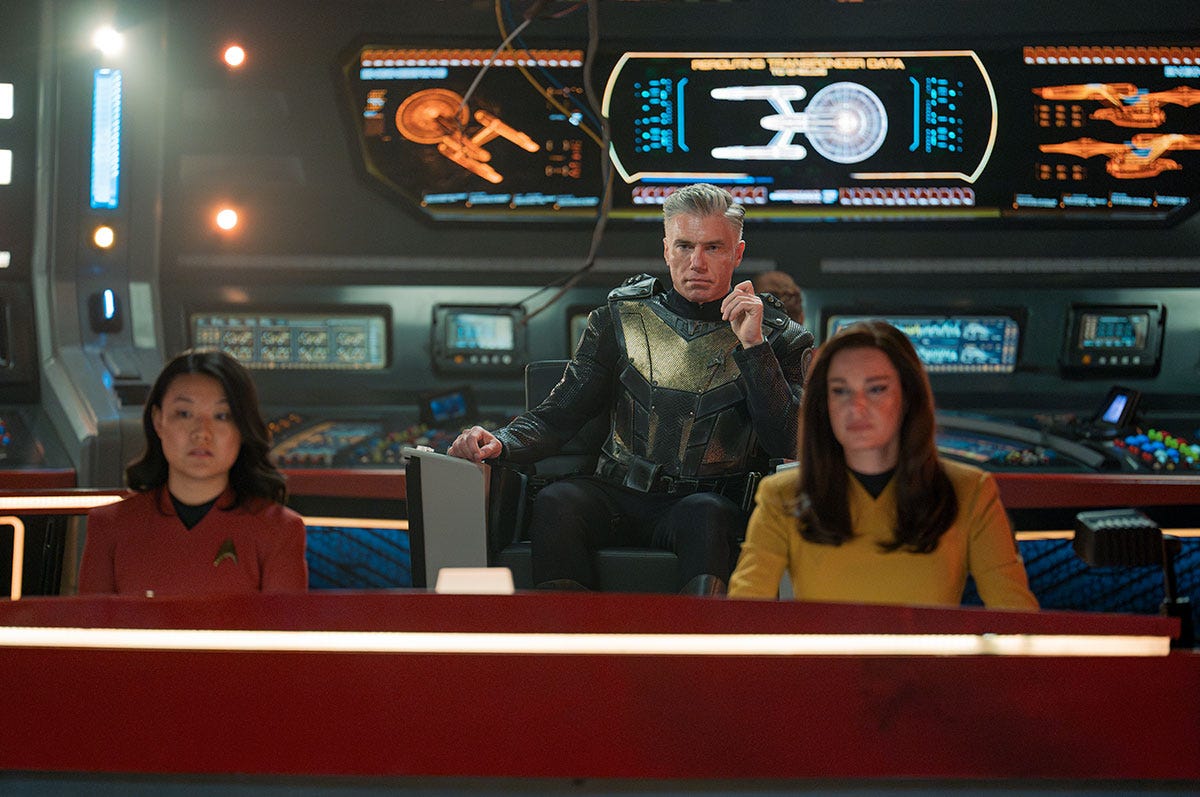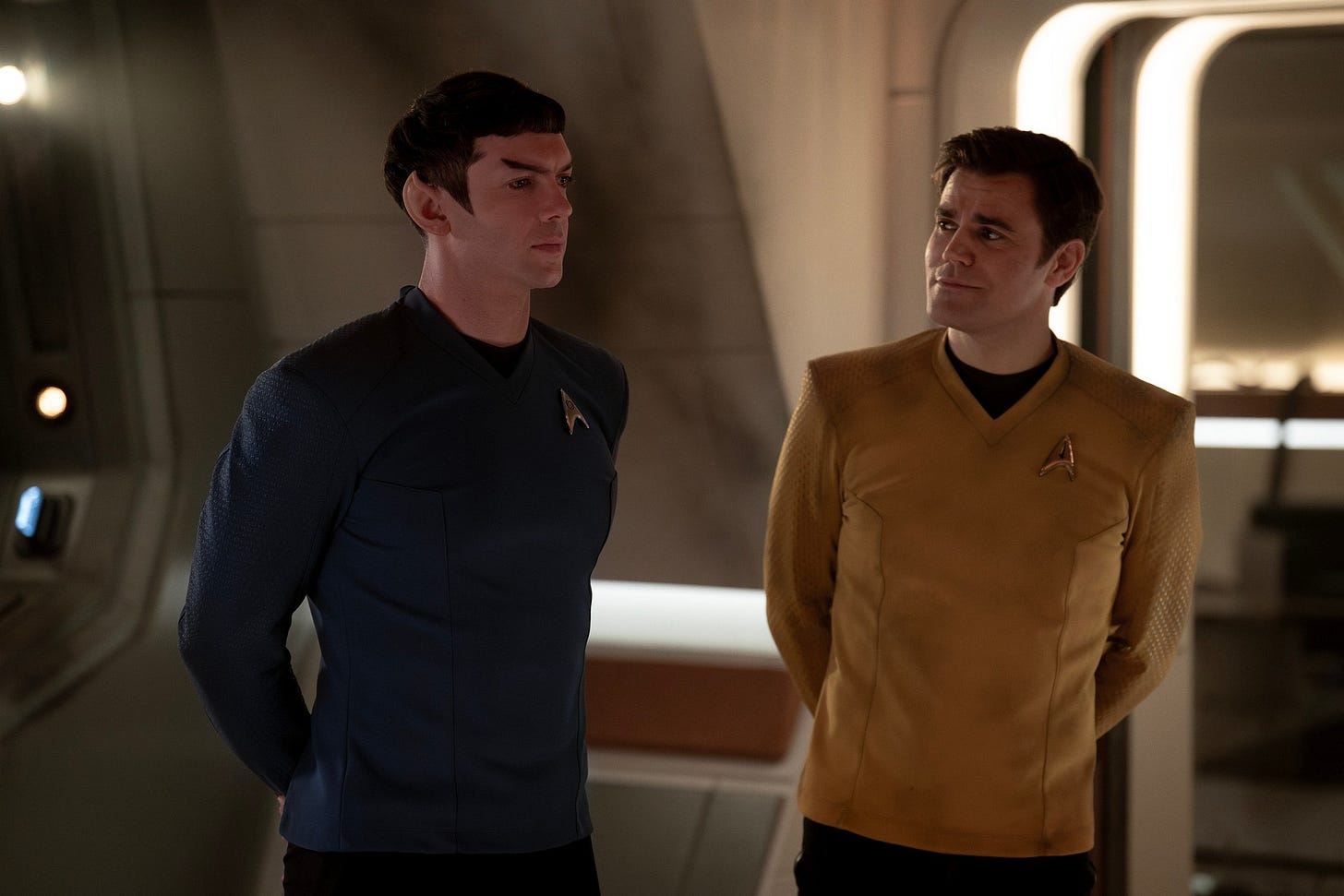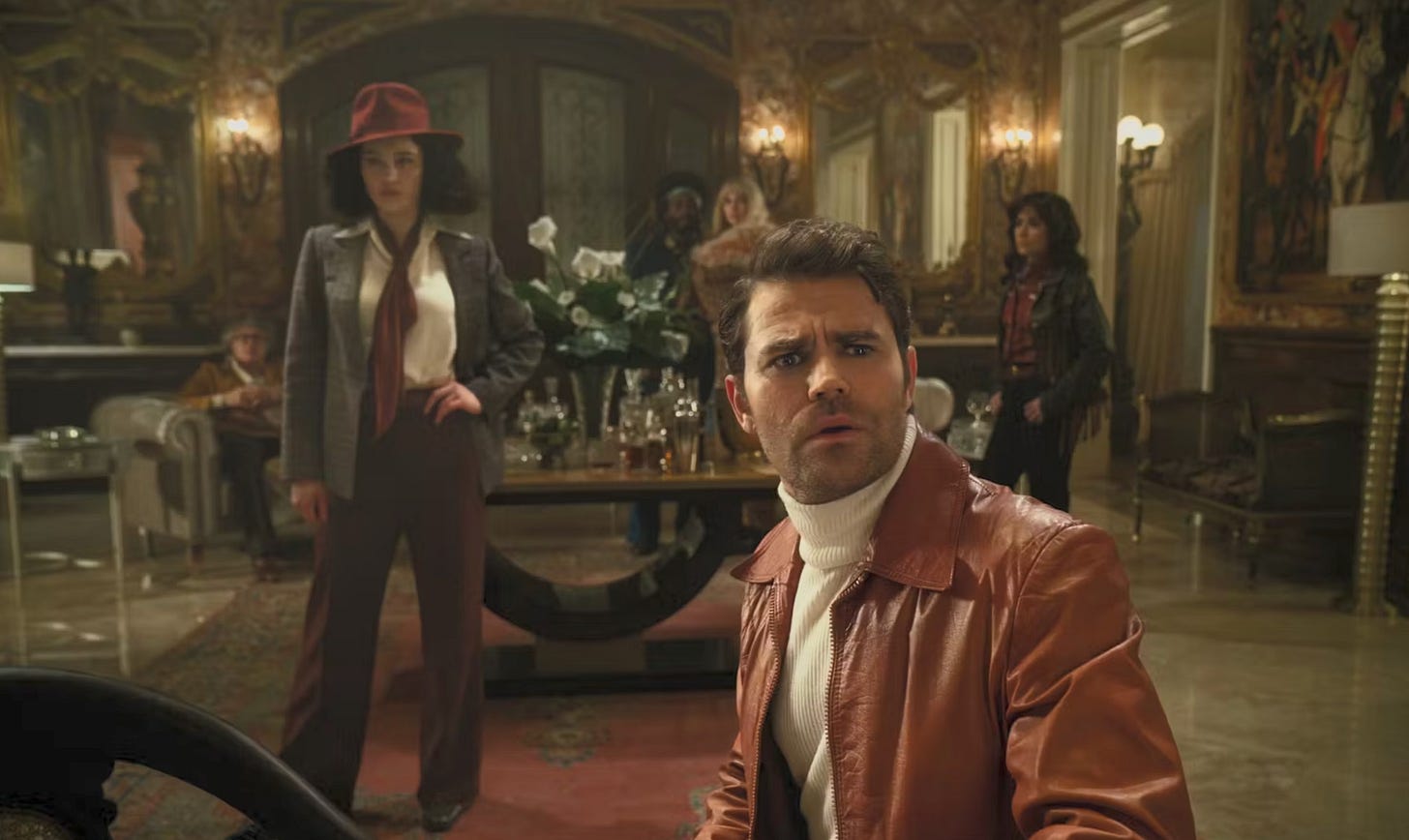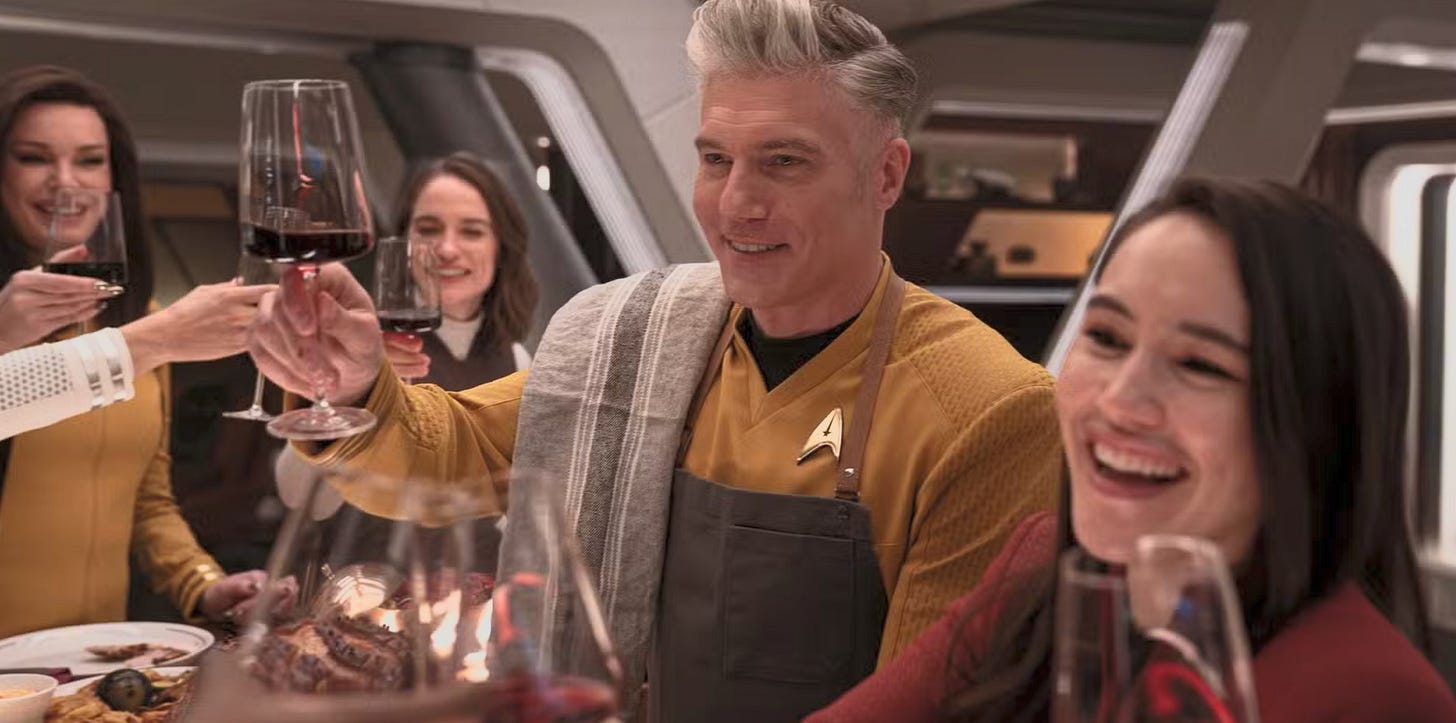Review: 'Star Trek: Strange New Worlds' (Season 3)
Captain Pike's five-year mission continues, confirming yet again that this is the series the entire franchise should strive for
Previously on Star Trek: Strange New Worlds, Captain Pike of the starship Enterprise was in hot water, so to speak, rescuing colonists outside Federation borders while fighting off a massive onslaught by the bloodthirsty aliens known as the Gorn. Now, the time has come to see if Pike, again played by the always stylishly groomed Anson Mount, can fend off the attack and save the day.
Hold on to your tricorders and self-sealing stem bolts. This one’s going to get nerdy!
Historically, Star Trek is perhaps the most iconic science fiction franchise in popular media, and yes, I can now hear the grumblings of my fellow Star Wars fans at that statement. Begun in the 1960s by American science fiction screenwriter and producer Gene Roddenberry, the franchise had a popular but rocky start, paving a progressive way through a media landscape that was conservative and set in its ways. It focused on diversity, inclusion, and tolerance in a society that was, to say the least, not known for these qualities, building a huge following as it went.
The first series, later dubbed Star Trek: The Original Series (as many follow-ups and spinoffs would appear in the decades since), produced three seasons and 79 episodes between 1966 and 1969. The cast, now equally iconic, consisted of William Shatner as Captain James T. Kirk, Leonard Nimoy as Commander Spock, DeForest Kelley as Dr. Leonard “Bones” McCoy, James Doohan as Lt. Commander Montgomery “Scotty” Scott, Nichelle Nichols as Lieutenant Nyota Uhura, George Takei as Lieutenant Hikaru Sulu, Walter Koenig as Ensign Pavel Chekov, and Majel Barrett as Nurse Christine Chapel.
It's also worth noting that the original, unaired pilot featured a different crew: Jeffrey Hunter starred as Captain Pike, and Majel Barrett played his second-in-command, "Number One."
Fast forward almost six decades, and Star Trek has cemented itself as an integral part of pop culture. It now includes a multitude of movies and television series that, while still championing the qualities Gene Roddenberry stood for, often explore other—and sometimes darker—aspects of the far future he envisioned.
But let’s reel it in a bit. We’re here to explore the hit series Star Trek: Strange New Worlds, specifically its third season of the five that are planned. And if you’re only jumping on now—an interesting choice, considering we’re in the middle of the story—I’ll say welcome aboard the starship Enterprise. We’re happy to have you!
I think a short crash course on where this series fits in is in order. Star Trek: Strange New Worlds is a spinoff of—or perhaps more accurately, a branch-off from—the series Star Trek: Discovery, which ran for five seasons from 2017 to 2024. The characters and premise for Strange New Worlds were introduced during the second season of Discovery, before branching off into their own series while Discovery continued its own narrative.
Therefore, to get the full backstory, watching the first two seasons of Star Trek: Discovery is recommended, as they introduce many of the key characters and their motivations.
The term Strange New Worlds comes from the opening monologue of many of the Star Trek series, as spoken by the captains of the various generations of the starship Enterprise:
“Space: the final frontier. These are the voyages of the starship Enterprise. Its five-year mission: to explore strange new worlds. To seek out new life and new civilizations. To boldly go where no one has gone before.”
This monologue embodies a hopeful and optimistic perspective on the future and the value of fellowship. This is not a series about hard-boiled anti-heroes flying around in space, blasting aliens, and fighting wars—although these things also happen. Star Trek is, first and foremost, about our present day as seen through the perspective of the future, examining and mirroring current events—whether in politics, philosophy, ethics, or culture—and testing them against a future backdrop.
Of all the Star Trek titles released since the 1960s, Star Trek: Strange New Worlds is the one most closely aligned with Gene Roddenberry’s original vision. Thus, it often explores the lighter sides of the franchise in a distinctly episodic manner. And while there are story arcs and red threads running through the seasons, it's often broken up with more lighthearted, humorous, and even soap-like episodes, often featuring prominent guest stars—like Rhys Darby (Our Flag Means Death, What We Do in the Shadows) in the second episode of this newest season—to break the tension.
The third season picks up exactly where the second left off, and the situation is bleak. The starship Enterprise was under heavy assault by the Gorn—bestial, reptilian aliens that use humans and other beings to hatch their young. The first episode, titled "Hegemony, Part II," continues that storyline, touching on both action and horror elements, before we are treated to the lighter and hilarious episode "Wedding Bell Blues," all about love and mistaken identities. The other three episodes I’ve watched of this season are equally varied, from space zombies to ancient mysteries, and even early explorations of the (in)famous Holodeck first seen in Star Trek: The Next Generation.
This structure of adding lighthearted stories into an otherwise action-filled season is an effective pressure valve; one that not only sets Star Trek: Strange New Worlds apart but also makes it arguably the best and most loved of the new Star Trek series.
The original gang is back, of course. Anson Mount is brilliant as Captain Pike. Utterly professional, but also warm and caring, stoic in the face of the dark fate he has seen in his future. Through these three seasons, and his appearance in Star Trek: Discovery, he has become my all-time favorite Star Trek captain—something I never thought was possible after Patrick Stewart’s Captain Jean-Luc Picard in Star Trek: The Next Generation, but here we are.
But a Captain needs his crew, and in Star Trek: Strange New Worlds, the writers have put together the best. The rest of the stellar crew also returns, with each actor getting their moment to shine: Rebecca Romijn as his second-in-command, "Number One," and Ethan Peck—grandson of the legendary Gregory Peck—as the fan-favorite half-Vulcan science officer, Spock.
The ensemble also includes Jess Bush as Nurse Christine Chapel, Christina Chong as the formidable chief of security La’an Noonien-Singh (a surname longtime fans will recognize), Celia Rose Gooding as the brilliant linguist Nyota Uhura, Melissa Navia as the hotshot helmsman Erica Ortegas, Babs Olusanmokun as Dr. Joseph M’Benga, Martin Quinn as the fledgling engineer Montgomery “Scotty” Scott, and the slightly batty, and very ancient Commander Pelia, played by Carol Kane.
That’s a lot of characters, especially considering they all get their time in the spotlight. But that’s the beauty of Star Trek: Strange New Worlds. It works precisely because of how the series uses the older episodic structure that is less common now in the age of streaming, where every episode is at our fingertips and we don’t have to worry about falling out of the story if we miss an episode, as was the case back in the age of linear television. This structure is, of course, a way to play on nostalgia, leaning on the series’ many references to Star Trek: The Original Series, which it endeavors to emulate.
That said, when watching this third season, it is also interesting to see some of the more surprising aspects where the series differs from the franchise—and indeed, much of modern popular media—as a whole. Compared to Star Trek: Discovery, Star Trek: Strange New Worlds feels decidedly less concerned with overtly playing on diversity, inclusiveness, and "woke" themes—for lack of a better, less-discussed term—than the series it sprang out of.
These elements are there, of course. Inclusiveness, diversity, and tolerance are what Star Trek is, or at least should be, all about. But Strange New Worlds is not so concerned with telling you about it in every other scene. Instead, the focus is squarely on the adventure and nostalgia, and it’s better for it.
With its third season, Star Trek: Strange New Worlds continues to be the prime example of what the franchise should strive for. Of course, movies and series strive for different tones and perspectives, but to me, as a Star Trek fan, none of them come close to capturing what is, in essence, a modern distillation of Gene Roddenberry’s amazing vision for a better world.
Season 3 of Star Trek: Strange New Worlds premieres on Paramount+ on July 17 and on SkyShowtime later in the month.








